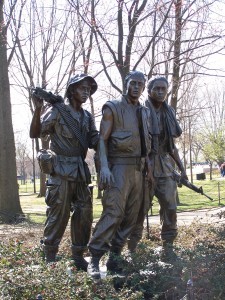Jan
10
Return To Vietnam
Filed Under Return To Vietnam
The drive from Halong Bay inland to Hanoi takes over three hours. I feel unsettled and somewhat apprehensive about making the trip into the communist capital city of Vietnam.
Yes, I know the war is over, but that alone doesn’t remove the lingering memories of Ho Chi Minh’s North Vietnamese Army (NVA) assaulting the South by the thousands. Since the French Army’s loss at the battle of Dien Bien Phu, Uncle Ho was determined to overrun South Vietnam and spread communism throughout the entire country. Saigon was the ultimate target, but thousands of battles would occur before that objective was met.
We have named that difficult and tragic time in American history the Vietnam War. The Vietnamese call it the American War – which allows them to distinguish that ten-year period from all the other wars – the war against the Chinese, the French, Japan during WWII, and then again the French, and finally against America. JFK had asked a nation “Ask not what your country can do for you, but what you can do for your country.”
In 1968, I found myself, along with thousands of other American youth answering that calling – we were patriotic – proud to serve our country. I was a young army officer at 21, older than most. How soon we would all age beyond our years.
Somehow, driving into Hanoi all these years later seemed unpatriotic. The country has been opened to tourism, albeit with a multitude of restrictions associated with communist rule. We visited Ho Chi Minh’s Mausoleum where his body has been immortalized for all to see since his death in 1969. Next we visited the Hoa Lo prison, “Hanoi Hilton”, where several hundred American pilots were tortured and held captive, including John McCain.
The photos in the Hanoi Hilton showed prisoners in various scenes “enjoying” their captivity. The propaganda was obvious to those of us who understood the realism of war, but to some of the more gullible individuals, the “upscale” conditions of the prison were impressive.
I was relieved and glad to leave the suffocating environment of Hanoi.
Later in the week, we moved southward into Danang and Hue, that portion of Vietnam below the DMZ more familiar to Americans – especially for those who served during the war. The battles of Khe Sanh, the Rockpile, Hue, and Operation Rolling Thunder are all too familiar. Although I was stationed further southwest along the South Vietnam / Cambodia Border, I had flown into the airfield at Danang. The sea of military vehicles and personnel are long gone, but the area looked much the same as I remembered it. Considerable development has occurred south of Danang and adjacent to China Beach, but much of the city appeared relatively unchanged from decades prior. The ridge line to the west of Danang, toward Dai La Pass, still was draped in clouds and looked as ominous as ever. And yes, the Viet Cong where still there, only today everyone is under communist rule so we no longer have to anguish over the dilemma of friend or foe.
Two days later, we arrived in Saigon (Ho Chi Minh City) although most of us still call it Saigon as do the residents of Vietnam. We drove past the Tan Son Nhut airport and moved into the city proper. Following a tour of Saigon and visiting the war museum, which featured a U.S. Army Uh-1 helicopter, an F-5 Air force fighter, a Sky hawk, and an army tank – all displaying a large emblem of the communist red star painted over the U.S. insignia.
That was enough tourist attraction for me…
Jan and I walked past the noted Continental Hotel and stopped at the Rex for an afternoon break.
The rooftop view from the outdoor lounge of the Rex Hotel allowed a panoramic glimpse of the city. We ordered a Saigon Sling and a Manhattan which somehow seemed appropriate. As I mellow-out and reflect on the war, I couldn’t help but remember all who had made the supreme sacrifice and had not returned home. As if it was yesterday, I remember my friend Bill McAtee from Hanna. We had been in contact and planned to meet in Lai Khe, my division base camp, in early December. The reunion never happened. Within three days of our meeting, I was wounded in action and Bill was killed. And of course there were many others. I also reflect on my high school and college classmates whose lives would forever be changed by the war. There was George Patton, Bill Blom, Dick Butler, Bill Bellamy, and the list goes on…
Today, on my birthday atop the Rex Hotel in downtown Saigon, I remember and celebrate their service to our country. Somehow I would like to think we made a difference.



